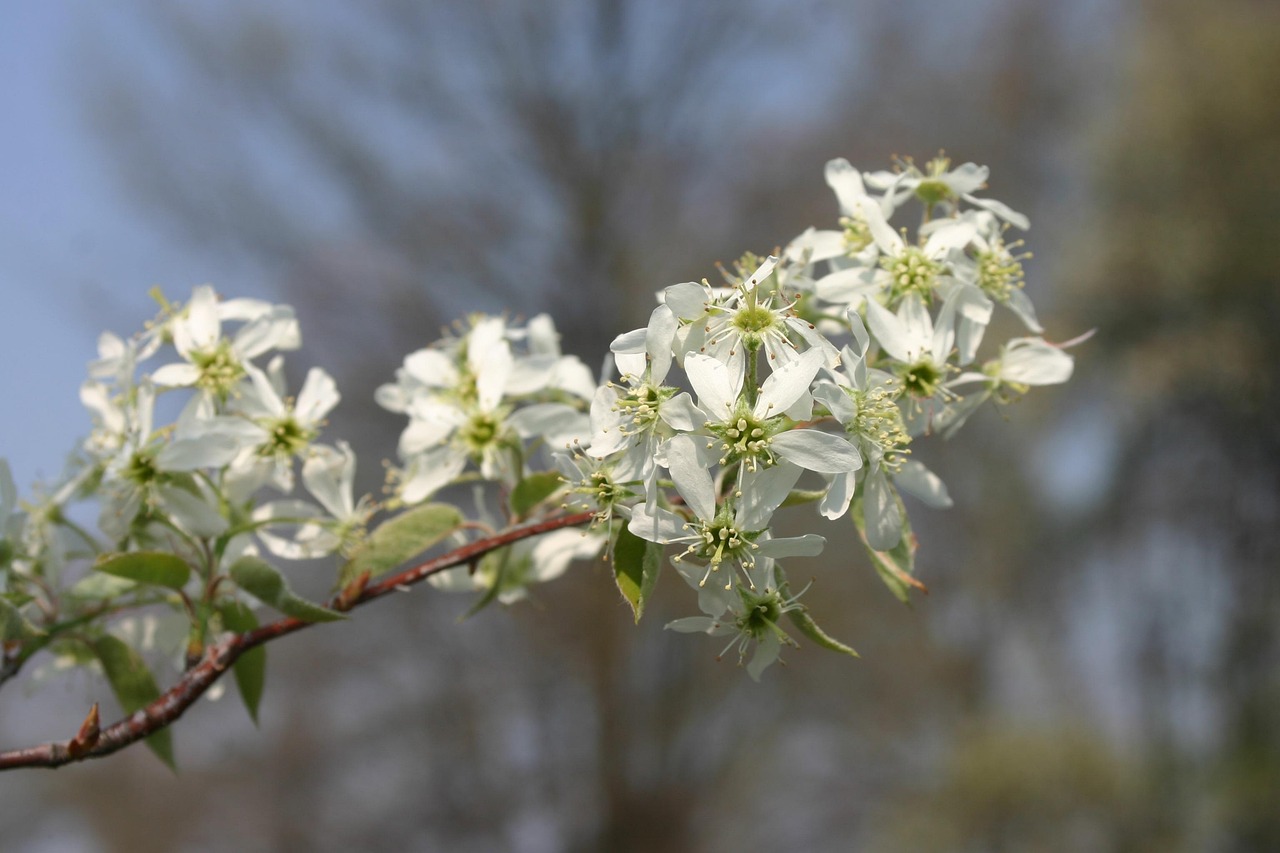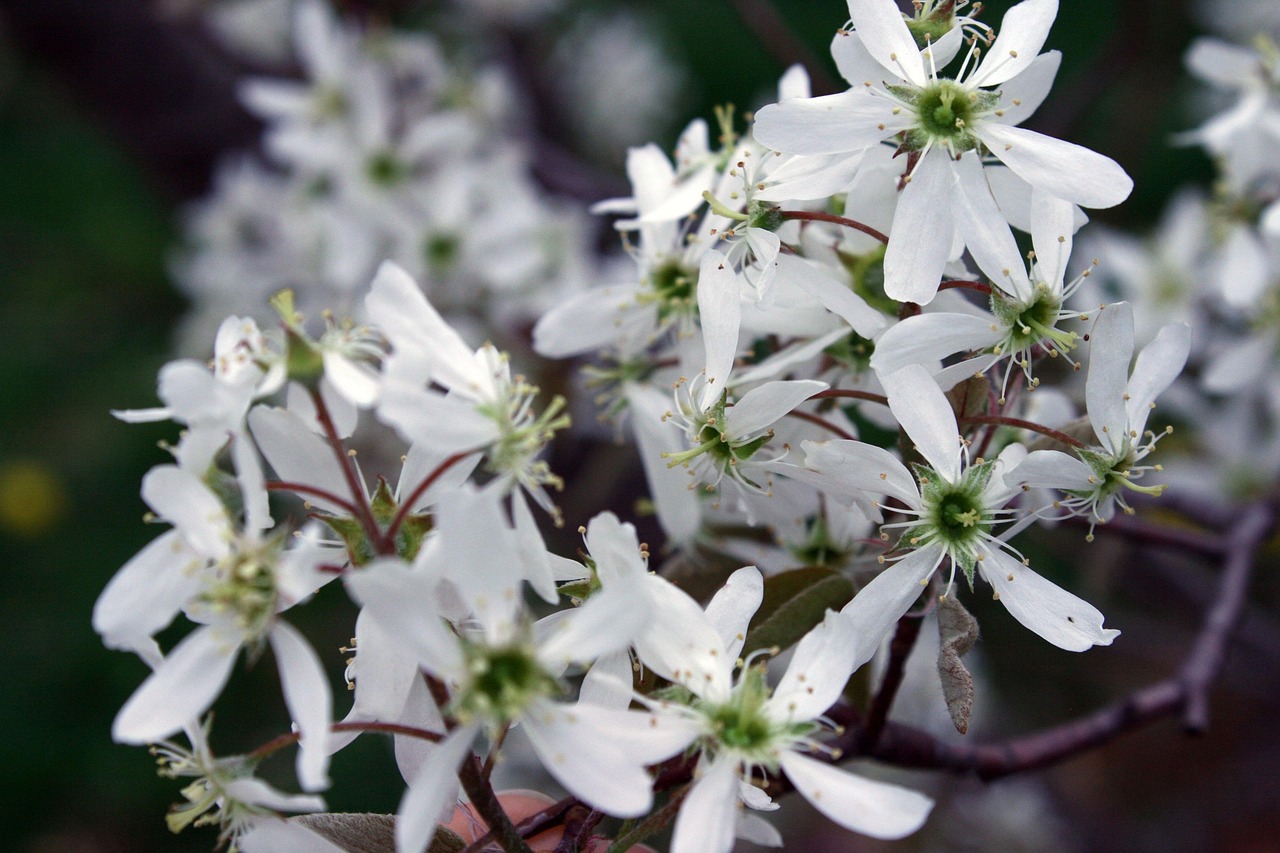The serviceberry tree typically has a moderate growth rate, averaging about 12 to 24 inches per year under optimal conditions. This makes it a popular choice for gardeners looking to establish spring berries in their landscapes.
The serviceberry tree, also known as Amelanchier, is a deciduous tree or shrub that is beloved for its beautiful spring flowers and delicious berries. This tree is native to North America and can be found in various habitats, from forests to open woodlands. The serviceberry is particularly valued for its early spring blooms, which attract pollinators and provide an essential food source for wildlife.

One of the most appealing aspects of the serviceberry tree is its growth rate. Understanding this growth rate is crucial for gardeners and landscapers who wish to incorporate this tree into their gardens. Knowing how quickly a serviceberry tree grows helps in planning for space, sunlight, and other environmental factors. In general, serviceberries are considered to have a moderate growth rate, typically reaching maturity within 5 to 10 years.
Factors Affecting Growth Rate
The growth rate of the serviceberry tree can be influenced by several factors. These include soil quality, climate, water availability, and sunlight exposure. Each of these factors plays a significant role in determining how fast the tree will grow and how many berries it will produce during the spring season.
- Soil Quality: Serviceberries thrive in well-drained, loamy soil rich in organic matter. Poor soil quality can stunt growth and reduce berry production.
- Climate: These trees prefer temperate climates with distinct seasons. They can tolerate cold winters but may struggle in extreme heat or humidity.
- Water Availability: Consistent moisture is essential for healthy growth. However, overwatering can lead to root rot.
- Sunlight Exposure: Full sun to partial shade is ideal. Insufficient sunlight can lead to slower growth and fewer berries.
These factors can be managed or improved to enhance the growth rate of serviceberry trees. For example, amending the soil with compost can improve nutrient availability. Similarly, proper watering practices can ensure that the trees receive adequate moisture without becoming waterlogged.

Ideal Conditions for Growth
To maximize the growth rate of serviceberry trees and enhance their berry production, it’s essential to provide them with ideal growing conditions. Here are some key recommendations:
| Condition | Recommendation |
|---|---|
| Soil Type | Loamy, well-drained soil with plenty of organic matter |
| pH Level | Acidic to neutral (pH 5.5 to 7.0) |
| Sunlight | Full sun (at least 6 hours of direct sunlight per day) |
| Watering | Regular watering during dry spells; avoid waterlogged conditions |
| Fertilization | A balanced fertilizer in early spring to promote growth |
By understanding these ideal conditions, gardeners can help their serviceberry trees reach their full potential. Proper care not only speeds up growth but also enhances the quality and quantity of berries produced each spring.
Another important aspect of serviceberry growth is its pruning needs. Regular pruning encourages healthy growth and can improve berry yield by allowing more sunlight to reach the branches. Pruning should ideally be done in late winter or early spring before new growth begins.

The serviceberry tree also has a unique adaptability that allows it to thrive in various environments. This adaptability contributes to its popularity among gardeners and landscape designers. Whether planted as a standalone specimen or in clusters, the serviceberry tree adds aesthetic value while providing delicious berries for both humans and wildlife.
Common Pests and Diseases
Although the serviceberry tree is relatively hardy, it can be susceptible to various pests and diseases that may impact its growth rate and berry production. Understanding these issues is vital for maintaining healthy trees and maximizing their yield.
Pests That Affect Serviceberry Trees
Several pests can damage serviceberry trees. These pests can harm the leaves, bark, or fruit, leading to reduced growth and poor berry quality. Here are some common pests to watch out for:

- Serviceberry Sawfly: This pest feeds on the leaves of the serviceberry tree. Infestations can lead to significant leaf loss, affecting photosynthesis and overall health.
- Spider Mites: These tiny pests suck the sap from leaves. Their presence can cause yellowing and webbing on the foliage, indicating stress in the tree.
- Scale Insects: Scale insects attach themselves to the branches and suck sap. Heavy infestations can weaken the tree and lead to dieback.
- Japanese Beetles: These beetles are known for their voracious appetite for leaves. They can create holes in the foliage, which may reduce the tree’s ability to produce berries.
Regular monitoring is essential for early detection of these pests. If you notice signs of infestation, consider using insecticidal soap or neem oil as organic treatment options.
Diseases Impacting Growth
Serviceberry trees are also prone to certain diseases that can hinder their growth and berry production. Being aware of these diseases allows for proactive management. Common diseases include:
- Cedar-Apple Rust: This fungal disease requires two hosts, cedar trees and serviceberries. Symptoms include orange-brown spots on the leaves. While it rarely kills the tree, it can weaken it.
- Powdery Mildew: This fungal disease manifests as a white powdery coating on leaves. It thrives in humid conditions and can hinder the tree’s growth if left untreated.
- Leaf Spot: Caused by various fungal pathogens, leaf spot results in dark spots on the leaves. Severe infections can lead to early leaf drop.
To prevent diseases, ensure good air circulation around the tree by pruning adequately. Additionally, avoid overhead watering to minimize humidity levels around foliage.
Optimal Fertilization Practices
Fertilization is a crucial component in promoting healthy growth rates in serviceberry trees. Proper feeding helps provide essential nutrients that enhance vigor and fruit production.
Types of Fertilizers
Selecting the right type of fertilizer is essential. Here are some popular options:
- Granular Fertilizers: These slow-release fertilizers provide nutrients over an extended period. They are often preferred for new plantings.
- Liquid Fertilizers: Quick-acting and easy to apply, liquid fertilizers can give a rapid boost of nutrients during the growing season.
- Organic Options: Compost and well-rotted manure are excellent organic fertilizers that improve soil health while providing nutrients.
When and How to Fertilize
The timing and method of fertilizing are important for maximizing effectiveness. Here are some guidelines:
- Timing: Fertilize in early spring before new growth begins. This timing allows the tree to access nutrients right when they need them most.
- Application: Spread granular fertilizers evenly around the root zone, avoiding direct contact with the trunk. For liquid fertilizers, dilute as per instructions and apply directly to the soil.
- Frequency: Generally, a single application in spring is sufficient. However, additional applications may be needed in poor soil conditions or if growth appears stunted.
A proper fertilization regimen can significantly affect the growth rate of serviceberry trees, enhancing their overall health and berry yield.
The Role of Watering
Watering is another critical factor influencing the growth rate of serviceberry trees. Proper hydration promotes healthy roots, vigorous growth, and optimal berry production.
Watering Guidelines
Here are some essential watering practices for serviceberry trees:
- Frequency: Newly planted serviceberry trees require regular watering until established, typically once or twice a week depending on rainfall.
- Deep Watering: Ensure deep watering to encourage roots to grow downward. This helps establish a robust root system that can access moisture more effectively.
- Avoid Waterlogging: Ensure that water drains well from the area surrounding the tree to prevent root rot. Mulching can help retain moisture while preventing soil compaction.
A proper watering regime will not only support growth but also enhance berry production during spring.
Seasonal Care for Serviceberry Trees
Providing seasonal care for serviceberry trees is essential for promoting healthy growth and ensuring optimal berry production. Each season brings unique challenges and opportunities for these trees, making it vital to adapt care routines accordingly.
Spring Care
Spring is a crucial time for serviceberry trees as they awaken from dormancy. Proper care during this season can set the stage for robust growth and fruitful harvests.
- Pruning: Early spring is an ideal time to prune serviceberry trees. Remove any dead or damaged branches to encourage healthy growth and improve airflow.
- Fertilization: Apply a balanced fertilizer as previously discussed. This will provide the necessary nutrients to support new growth and flowering.
- Watering: As temperatures begin to rise, monitor soil moisture closely. Ensure that trees receive adequate water, especially if spring is unusually dry.
- Pest Monitoring: Keep an eye out for pests such as sawflies and spider mites that may emerge in spring. Early detection allows for timely management.
Summer Care
Summer presents its own set of challenges, such as heat stress and potential drought conditions. Effective summer care is essential for the longevity of serviceberry trees.
- Watering Frequency: During hot months, increase watering frequency to maintain consistent soil moisture. Aim for deep watering to encourage root development.
- Mulching: Apply a layer of mulch around the base of the tree. This helps retain moisture, suppress weeds, and regulate soil temperature.
- Pest and Disease Management: Continue monitoring for pests and diseases. Control measures should be applied promptly to avoid damage during this critical growth phase.
Fall Care
As the growing season winds down, fall care focuses on preparing serviceberry trees for winter dormancy.
- Final Watering: Ensure that trees are adequately watered before winter sets in. This helps them withstand cold temperatures and reduces stress during dormancy.
- Fertilization: A light application of fertilizer in early fall can support root health without encouraging excessive top growth just before winter.
- Leaf Cleanup: Rake up fallen leaves and debris around the tree to prevent diseases that could overwinter in the soil.
Winter Care
While serviceberry trees are dormant in winter, some care practices can help ensure their health when spring arrives.
- Mulching: Apply a layer of organic mulch around the base of the tree to insulate roots and protect them from temperature fluctuations.
- Protection from Wildlife: In areas with deer or rabbits, consider using tree guards or fencing to prevent damage from browsing.
- Monitoring: Periodically check for winter damage, such as broken branches or signs of disease, to address any issues before spring blooms.
Harvesting Spring Berries
The serviceberry tree produces small, sweet berries that are typically ready for harvest in late spring to early summer. Understanding how and when to harvest these berries can maximize enjoyment and culinary uses.
Identifying Ripeness
Knowing when the berries are ripe is crucial for a successful harvest. Here are some signs to look for:
- Color Change: Ripe serviceberries typically turn a deep purple or blue color. Unripe berries are usually red or greenish.
- Ease of Harvesting: Ripe berries should come off the stem easily when gently tugged. If they resist, they may need more time on the tree.
- Taste Test: Sampling a berry is an excellent way to determine ripeness. Ripe berries should taste sweet and flavorful.
Harvesting Techniques
When harvesting serviceberries, employ gentle techniques to avoid damaging the tree or the fruit. Here are some tips:
- Choose a Dry Day: Harvest berries on a dry day to prevent mold or spoilage during handling.
- Use Clean Containers: Have clean baskets or containers ready to collect berries without crushing them.
- Gentle Handling: Pick berries by pinching them off gently with your fingers or using scissors if necessary. Avoid pulling hard on the stems.
Serviceberries can be enjoyed fresh, used in jams, or added to baked goods. Their versatility makes them a delightful addition to various culinary creations.
Culinary Uses of Serviceberries
The sweet flavor of serviceberries makes them suitable for various recipes. Here are some popular ways to use these delicious fruits:
- Pies and Tarts: Serviceberries can be used in pies or tarts, providing a unique flavor that pairs well with other fruits like apples or blueberries.
- Syrups and Jams: Making syrups or jams with serviceberries captures their sweetness and allows for long-term storage.
- Baked Goods: Add serviceberries to muffins, pancakes, or bread for a burst of flavor and nutrition.
The use of serviceberries in the kitchen not only showcases their delightful taste but also encourages gardeners to cultivate these trees for both aesthetic and culinary benefits.
Health Benefits of Serviceberries
In addition to their culinary versatility, serviceberries offer numerous health benefits. These berries are not only delicious but also packed with essential nutrients that contribute to overall well-being.
Nutritional Profile
Serviceberries are rich in vitamins and minerals, making them a nutritious choice for a healthy diet. Here are some key components found in serviceberries:
- Vitamins: Serviceberries are a good source of vitamin C, which supports immune function and skin health.
- Antioxidants: These berries contain high levels of antioxidants, such as flavonoids and phenolic compounds, which help combat oxidative stress and inflammation in the body.
- Fiber: Serviceberries are an excellent source of dietary fiber, promoting digestive health and aiding in weight management.
- Minerals: They provide essential minerals such as potassium and manganese, which play vital roles in various bodily functions.
Incorporating serviceberries into your diet can contribute to improved health and well-being. Their sweet flavor makes it easy to add them to meals or snacks without sacrificing nutrition.
Landscaping Benefits of Serviceberry Trees
Serviceberry trees are not only valuable for their fruits but also for their aesthetic appeal and ecological benefits in landscaping. Here are some reasons why you should consider planting serviceberries in your garden or landscape design:
- Seasonal Interest: Serviceberry trees provide year-round beauty. In spring, they bloom with delicate white flowers, followed by lush green foliage in summer. In fall, the leaves turn vibrant shades of yellow and orange, while the berries attract wildlife.
- Wildlife Habitat: The berries serve as a food source for various birds and mammals. Planting serviceberry trees can enhance biodiversity in your garden.
- Soil Improvement: Serviceberries have a fibrous root system that helps improve soil structure and prevent erosion. They are also adaptable to a range of soil types.
- Low Maintenance: Once established, serviceberry trees require minimal care. They are generally pest-resistant and can thrive in various environmental conditions.
These attributes make serviceberry trees an excellent choice for both ornamental and functional purposes in landscaping.
Cultivating Serviceberries in Different Environments
Serviceberry trees can adapt to a variety of growing environments. Understanding how to cultivate them effectively in different settings can lead to successful growth and berry production.
Urban Gardening
In urban areas, space is often limited. Serviceberry trees can thrive in small gardens or even as street trees. They do well in containers if adequate care is taken. Here are some tips for urban gardening with serviceberries:
- Select Dwarf Varieties: Choose dwarf or compact varieties of serviceberry for container gardening or small spaces.
- Ensure Adequate Drainage: Use well-draining potting soil and ensure containers have drainage holes to prevent waterlogging.
- Monitor Sunlight: Place containers in locations that receive full sun to partial shade for optimal growth.
Rural and Suburban Gardening
In rural or suburban settings, serviceberries can be planted as part of a larger landscape. Here are some considerations:
- Spacing: When planting multiple trees, space them adequately to allow for their mature size and to promote airflow between trees.
- Companion Planting: Serviceberries can be paired with other native plants that support pollinators and wildlife, creating a thriving ecosystem.
- Water Management: In areas prone to drought, strategies such as rainwater harvesting can be employed to support consistent watering.
Conclusion
The serviceberry tree is a remarkable addition to any garden or landscape, offering not only beautiful spring blooms but also delicious berries packed with nutrients. With a moderate growth rate and adaptability to various environments, these trees can thrive under the right conditions. By understanding their care requirements, including watering, fertilization, pest management, and seasonal maintenance, gardeners can ensure robust growth and fruitful harvests.
Whether used for culinary purposes or as a focal point in landscaping, serviceberries provide aesthetic appeal and ecological benefits. Their role as a food source for wildlife further enhances their value in promoting biodiversity. As gardeners embrace the many benefits of serviceberries, they contribute to healthier diets and vibrant ecosystems. Overall, serviceberry trees are a wonderful choice for those looking to enrich their gardens with beauty and bounty.
